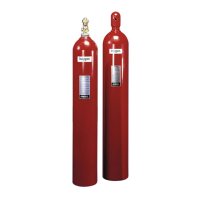CAUTION
!
The flow rates established in this and the following steps
are estimated flow rates only. These flow rates are esti-
mate solely for the purpose of estimating device sizes for
quotation purposes. The flow calculation program will
calculate actual system flow rates.
APPLICATION METHOD (Continued)
Total Flooding (Continued)
STEP NO. 15 – Determine the 90% system discharge
time
This step is used to determine the discharge time for 90%
of the agent. 90% of the agent is used by the flow calcula-
tion program instead of 100% because it provides a more
accurate flow calculation due to the low pressures and flow
rates associated with the final 10% of the agent discharge.
NOTE: In most cases 90% of the agent will discharge from
the system during the first half of the discharge time, the
remaining 10% of agent will require approximately the
same amount of time to discharge as the first 90%.
The discharge time established in this step will assure that
the agent concentration reaches 95% of the Minimum
Design Concentration within 60 seconds as required by
NFPA 2001. Varying the discharge time based on Design
Concentration at Normal Ambient Temperature allows
design of a system with lower flow rates and smaller pipe
sizes because the extra agent (the amount over that neces-
sary to reach 95% of Minimum Design Concentration) is
discharged after 60 seconds.
To complete this step, refer to the Discharge Time Chart on
Page 5-21 in this section. Locate the Design Concentration
determined in Step No. 14 in the left column and read to
the right to determine the Discharge Time. Interpolation of
the Design Concentration and Discharge Time may be nec-
essary.
Underwriters Laboratories limits the 90% discharge time of
unbalanced INERGEN systems to 132 seconds. If the time
determined from the Discharge Time Chart on Page 5-21
exceeds 132 seconds, and the system must be UL listed,
the discharge time must be determined as 132 seconds.
Complete this step for each area protected by the system.
NOTE: Utilization of these discharge times is necessary to
achieve 95% of the minimum design concentration within
one minute.
Example
Design Concentration For All Areas = 38.4%
Discharge Time = 84 seconds
(Note: Discharge times less
than or equal to those shown on the chart are acceptable)
STEP NO. 16 – Determine the Estimated System Flow
Rate
This step is required to estimate the Manifold Orifice Device
size, the downstream pipe sizes, and to determine pres-
sure-venting requirements.
To estimate the system flow rate (CFM), first multiply the
total quantity of actual agent supplied
by 0.9 (90%), and
then divide that number by the total discharge time (in min-
utes).
(Total agent supplied (from Step No. 9) x 0.9) ÷ discharge
time (in minutes)
NOTE: The flow rate established during this step is an esti-
mated flow rate only. Actual system performance will most
likely vary from that calculated here. It is the Designer’s
responsibility to determine suitability of this estimate. It may
be advisable to increase a pipe size if the estimate
approaches the maximum flow rate for a given pipe size.
Example
1144 ft
3
Total Agent Supplied x 0.9 = 1030 ÷ 1.4 Discharge
Time in Minutes = 736 CFM Estimated System Flow Rate
STEP NO. 17 – Estimate the pressure reducer size
required
Using the flow rate established in Step No. 16, refer to the
Pipe Sizing Estimation Chart (Manifold Pipe Size) on Page
5-14 to determine the estimated Pressure Reducer size.
INERGEN manifolds require the use of Schedule 80 or
Schedule 160 pipe depending on the size of pipe and join-
ing methods. Threaded manifolds larger than 2 1/2 in. pipe
size will require Schedule 160 pipe, welded manifolds will
require Schedule 80 pipe in all sizes.
NOTE: It may be in the Designer’s best interest to increase
the estimated size if the estimated flow rate approaches the
upper limit for the pipe size indicated, especially if Schedule
160 pipe is required.
Example
736 CFM = 3/4 in. Pressure Reducer
SECTION V
UL EX-4510 12-1-01 Page 5-6
Design

